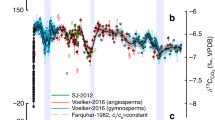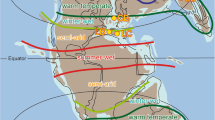Abstract
Quantitative reconstructions of atmospheric CO2 by using terrestrial and marine records are critical for understanding the so-called “greenhouse” conditions in the Cretaceous, but data from terrestrial plants for several stages of this period remain quite limited. Using the stomatal index (SI) technique, here we estimate the Santonian (Late Cretaceous) CO2 contents based on a sequence of fossil cuticles of Ginkgo adiantoides (Ung.) Heer from three beds of the Yong’ancun Formation in Jiayin, Heilongjiang Province, northeastern China. By the regress function, SIs of Ginkgo fossils reveal a pronounced CO2 reduction from the early to late Santonian (∼661 and ∼565 ppm, respectively). The relatively high CO2 levels provide additional evidence for paleoclimatic warmth in this interval. Moreover, available paleobotanical data illustrate a decline trend of CO2 contents throughout the Late Cretaceous, punctuated by several fluctuations in particular episodes with different magnitudes. The CO2 contents shifted notably in the late Cenomanian, Turonian, early Santonian, late Campanian, and probably latest Maastrichtian. Furthermore, a comprehensive study based on CO2 data shows that the global mean land surface temperature (GMLST) fluctuated several times accordingly. The change ratios of GMLST (ΔT) increased from ∼3°C in late Cenomanian to ∼4.7°C in mid Turonian, and then dramatically reduced to ∼2.2°C in mid Coniacian. From the Santonian onward, it appears that the temperature gradually decreased with a few minor fluctuations.
Similar content being viewed by others
References
Wang C S, Hu X M, Sarti M, et al. Upper Cretaceous oceanic red beds in southern Tibet: A major change from anoxic to oxic, deep-sea environments. Cretaceous Res, 2005, 26: 21–32
Alvarez L W, Alvarez W, Asaro F, et al. Extraterrestrial cause for the Cretaceous-Tertiary extinction-experimental results and theoretical interpretation. Science, 1980, 208: 1095–1108
McElwain J, Willis K J, Lupia R. Cretaceous CO2 decline and the radiation and diversification of angiosperms. In: Ehleringer J R, Cerling T E, Dearing M D, eds. A History of Atmospheric CO2 and its Effects on Plants, Animals, and Ecosystems. Berlin: Springer-Verlag, 2005. 133–165
Davies A, Kemp A E S, Pike J. Late Cretaceous seasonal ocean variability from the Arctic. Nature, 2009, 460: 254–258
Royer D L, Berner R A, Park J. Climate sensitivity constrained by CO2 concentrations over the past 420 million years. Nature, 2007, 446: 530–532
Heimhofer U, Hochuli P A, Burla S, et al. Timing of Early Cretaceous angiosperm diversification and possible links to major paleoenvironmental change. Geology, 2005, 33: 141–144
Berner R A. GEOCARB II: A revised model of atmospheric CO2 over Phanerozoic time. Am J Sci, 1994, 294: 56–91
Berner R A, Kothavala Z. GEOCARB III: A revised model of atmospheric CO2 over Phanerozoic time. Am J Sci, 2001, 301: 182–204
Ekart D D, Cerling T E, Montanez I P, et al. A 400 million year carbon isotpe record of pedogenic carbonate: Implications for paleoatomosperic carbon dioxide. Am J Sci, 1999, 299: 805–827
Tajika E. Carbon cycle and climate change during the Cretaceous inferred from a biogeochemical carbon cycle model. Island Arc, 1999, 8: 293–303
Beerling D J, Lomax B H, Royer D L, et al. An atmospheric PCO2 reconstruction across the Cretaceous-Tertiary boundary from leaf megafossils. Proc Nat Acad Sci USA, 2002, 99: 7836–7840
Haworth M, Hesselbo S P, McElwain J C, et al. Mid-Cretaceous PCO2 based on stomata of the extinct conifer Pseudofrenelopsis (Cheirolepidiaceae). Geology, 2005, 33: 749–752
Passalia M G. Cretaceous PCO2 estimation from stomatal frequency analysis of gymnosperm leaves of Patagonia, Argentina. Palaeogeogr Palaeoclimatol Palaeoecol, 2009, 273: 17–24
Quan C, Sun C, Sun Y, et al. High resolution estimates of paleo-CO2 levels through the Campanian (Late Cretaceous) based on Ginkgo cuticles. Cretaceous Res, 2009, 30: 424–428
Retallack G J. A 300-million-year record of atmospheric carbon dioxide from fossil plant cuticles. Nature, 2001, 411: 287–290
Sun B N, Xiao L, Xie S P, et al. Quantitative analysis of paleoatmospheric CO2 level based on stomatal characters of fossil Ginkgo from Jurassic to Cretaceous in China. Acta Geol Sin-Engl Ed, 2007, 81: 931–939
Kürschner W M. Leaf sensor for CO2 in deep time. Nature, 2001, 411: 247–248
Beerling D J, Royer D L. Fossil plants indicators of the Phanerozoic global carbon cycle. Annu Rev Earth Planet Sci, 2002, 30: 527–556
Hetherington A M, Woodward F I. The role of stomata in sensing and driving environmental change. Nature, 2003, 424: 901–907
Goodwin S M, Jenks M A. Plant cuticle function as a barrier to water loss. In: Matthew A, Jenks P M H, eds. Plant Abiotic Stress. Oxford: Blackwell Publishing, 2007. 14–36
Pillitteri L J, Sloan D B, Bogenschutz N L, et al. Termination of asymmetric cell division and differentiation of stomata. Nature, 2007, 445: 501–505
Wright I J, Reich P B, Westoby M, et al. The worldwide leaf economics spectrum. Nature, 2004, 428: 821–827
Woodward F I. Stomatal numbers are sensitive to increases in CO2 from pre-industrial levels. Nature, 1987, 327: 617–618
Royer D L, Wing S, Beerling D J, et al. Paleobotanical evidence for near present day levels of atmospheric CO2 during part of the Tertiary. Science, 2001, 292: 2310–2313
Royer D L. Stomatal density and stomatal index as indicators of paleoatmospheric CO2 concentration. Rev Palaeobot Palynol, 2001, 114: 1–28
Sun B N, Yan D F, Xie S P, et al. Stomata and Carbon Isotope of Fossil Plants and Their Applications (in Chinese). Beijing: Science Press, 2009. 1–222
Xie S, Sun B, Yan D, et al. Altitudinal variation in Ginkgo leaf characters: Clues to paleoelevation reconstruction. Sci China Ser D-Earth Sci, 2009, 52: 2040–2046
Bureau of Geology and Mineral Resources of Heilongjiang Province. Regional Geology of Heilongjiang Province (in Chinese). Beijing: Geological Publishing House, 1993. 1–736
Sun G, Akhmetiev M, Golovneva L, et al. Late Cretaceous plants from Jiayin along Heilongjiang River, Northeast China. Forsch Inst Senck, 2007, 258: 75–83
Quan C, Sun G. Late Cretaceous aquatic angiosperms from Jiayin of Heilongjiang, Northeast China. Acta Geol Sin-Engl Ed, 2008, 82: 1133–1140
Royer D L. Estimating latest Cretaceous and Tertiary atmospheric CO2 from stomatal indices. In: Wing S L, Gingerich P D, Schmitz B, et al., eds. Causes and Consequences of Globally Warm Climates in the Early Paleogene. Boulder: The Geological Society of America, 2003. 79–93
Tralau H. Evolutionary trends in the genus Ginkgo. Lethaia, 1968, 1: 63–101
Royer D L, Hickey L J, Wing S L. Ecological conservatism in the “living fossil” Ginkgo. Paleobiology, 2003, 29: 84–104
Quan C, Sun G, Zhou Z. A new Tertiary Ginkgo (Ginkgoaceae) from the Wuyun Formation of Jiayin, Heilongjiang, northeastern China and its paleoenvironmental implications. Am J Bot, 2010, 97: 446–457
McElwain J C. Do fossil plants signal palaeoatmospheric CO2 concentration in the geological past? Philos T R Soc B, 1998, 353: 83–96
Kothavala Z, Oglesby R J, Saltzman B. Sensitivity of equilibrium surface temperature of CCM3 to systematic changes in atmospheric CO2. Geophys Res Lett, 1999, 26: 209–212
Ding Z L, Duan X N, Ge Q S, et al. On the major proposals for carbon emission reduction and some related issues. Sci China Earth Sci, 2010, 53: 159–172
Nordt L, Atchley S, Dworkin S I. Paleosol barometer indicates extreme fluctuations in atmospheric CO2 across the Cretaceous-Tertiary boundary. Geology, 2002, 30: 703–706
Wallmann K. Controls on the Cretaceous and Cenozoic evolution of seawater composition, atmospheric CO2 and climate. Geochim Cosmochim Acta, 2001, 65: 3005–3025
Forster A, Schouten S, Baas M, et al. Mid-Cretaceous (Albian-Santonian) sea surface temperature record of the tropical Atlantic Ocean. Geology, 2007, 35: 919–922
Arthur M A, Dean W E, Schlanger S O. Variations in the global carbon cycle during the Cretaceous related to climate, volcanism, and changes in atmospheric CO2. Geophys Monogr, 1985, 32: 504–29
Chen L Q, Li C S, Chaloner W G, et al. Assessing the potential for the stomatal characters of extant and fossil Ginkgo leaves to signal atmospheric CO2 change. Am J Bot, 2001, 88: 1309–1315
Berner R A. The rise of plants and their effect on weathering and atmospheric. Science, 1997, 276: 544–546
Fletcher B J, Beerling D J, Brentnall S J, et al. Fossil bryophytes as recorders of ancient CO2 levels: Experimental evidence and a Cretaceous case study. Global Biogeochem Cycles, 2005, 19: 1–13
Hegerl G C, Crowley T J, Hyde W T, et al. Climate sensitivity constrained by temperature reconstructions over the past seven centuries. Nature, 2006, 440: 1029–1032
Royer D L. CO2-forced climate thresholds during the Phanerozoic. Geochim Cosmochim Acta, 2006, 70: 5665–5675
Li X, Jenkyns H C, Wang C, et al. Upper Cretaceous carbon- and oxygen-isotope stratigraphy of hemipelagic carbonate facies from southern Tibet, China. J Geol Soc, 2006, 163: 375–382
Author information
Authors and Affiliations
Corresponding author
Rights and permissions
About this article
Cite this article
Wan, C., Wang, D., Zhu, Z. et al. Trend of Santonian (Late Cretaceous) atmospheric CO2 and global mean land surface temperature: Evidence from plant fossils. Sci. China Earth Sci. 54, 1338–1345 (2011). https://doi.org/10.1007/s11430-011-4267-1
Received:
Accepted:
Published:
Issue Date:
DOI: https://doi.org/10.1007/s11430-011-4267-1




